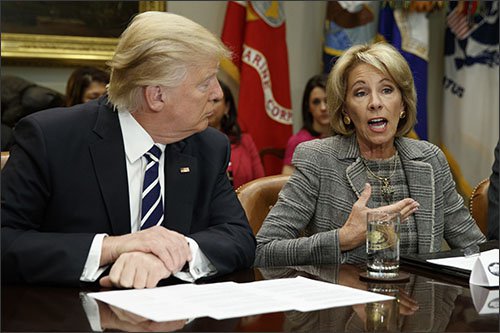Washington — U.S. Secretary of Education Betsy DeVos today announced new flexibility for school districts to create equitable, student-centered funding systems under a pilot program authorized by the Every Student Succeeds Act (ESSA).
“This is a great opportunity for local district leaders to put students first,” said Secretary DeVos. “Instead of relying on complex federal rules to allocate funds, local leaders can use this flexibility to match funds—local, State or Federal—to the needs of students.”
The flexibility will allow school districts to combine eligible Federal funds with State and local funds in order to allocate resources to schools based on the number of students and the corresponding level of need. This type of system, often called “student-centered funding” or “weighted student funding”, is widely considered to be a modern, transparent and quantifiable way to allocate resources to the students most in need.
Previously, inflexible rules guiding the allocation and use of Federal funds made it difficult for school districts to create student-centered funding systems using Federal, State and local funds. School districts awarded flexibility will be relieved from Federal funding rules that would otherwise prevent them from implementing a student-centered funding system. ESSA provides for up to fifty school districts to receive the flexibility during the first three years of the program.
School districts that receive the flexibility are expected to design and implement a student-centered funding system that meets all statutory requirements of the pilot program, including the use of weights that allocate substantially more funding to students from low-income families, to English learners and to any other educationally disadvantaged student group identified by the school district.
School districts that receive the flexibility must also provide an assurance that parents, teachers, school leaders and other relevant stakeholders are consulted in the development and implementation of the student-centered funding system.
The application will open on February 7, 2018. For applicants intending to use the flexibility during the 2018-2019 school year, the application is due by March 12, 2018. For applicants intending to use the flexibility during the 2019-2020 school year, the application is due by July 15, 2018.
Link: https://www2.ed.gov/policy/elsec/leg/essa/scfp/studentcentered.html
Frequently Asked Questions
1. Who may apply?
All local educational agencies (LEAs) are eligible to apply. The Department is authorized to award flexibility to 50 LEAs.
2. How do you apply?
The application will be available for download from the Department of Education website beginning February 7, 2018. Completed applications can be submitted to weightedfundingpilot@ed.gov.
3. What is being awarded?
The program will award flexibility only. It does not include a financial award.
4. When is the application due?
For LEAs that indicate on their application that they plan to use the flexibility during the upcoming 2018-2019 school year, the application is due by March 12, 2018. For LEAs that indicate they plan to use the flexibility during the 2019-2020 school year, the application is due by July 15, 2018.
For LEAs that will not use the flexibility until the 2019-2020 school year, the time between award and use may be used for planning.
5. When will the flexibility be awarded?
The Department intends to award the flexibility on a rolling basis, with those LEAs that apply to use the flexibility during the 2018-2019 school year receiving the earliest award notices.
6. Where can I go for additional information?
Prospective applicants can email weightedfundingpilot@ed.gov with questions or comments.
Please consult Title I, Part E, Section 1501 of the Elementary and Secondary Education Act (ESEA) as amended by the Every Student Succeeds Act (ESSA) for all applicable statutory requirements for participation in the program.

 The question: This one comes from a school-based leader who preferred to remain anonymous. This leader wants to know “What are the federal guidelines for ‘testing transparency?’ Schools are mandated to get 95 percent participation, but how is that possible is we tell parents of their opt out rights?”
The question: This one comes from a school-based leader who preferred to remain anonymous. This leader wants to know “What are the federal guidelines for ‘testing transparency?’ Schools are mandated to get 95 percent participation, but how is that possible is we tell parents of their opt out rights?”

 Contact: Press Office, (202) 401-1576,
Contact: Press Office, (202) 401-1576, 






